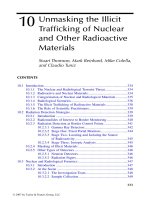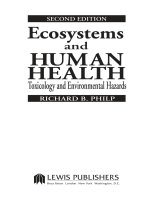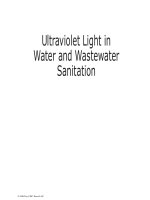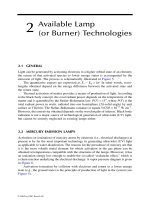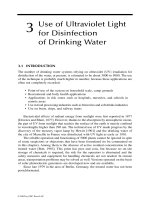Ultraviolet Light in Water and Wastewater Sanitation - Chapter 1 pptx
Bạn đang xem bản rút gọn của tài liệu. Xem và tải ngay bản đầy đủ của tài liệu tại đây (258.78 KB, 18 trang )
© 2002 by CRC Press LLC
Ultraviolet Light in
Water and Wastewater
Sanitation
LEWIS PUBLISHERS
A CRC Press Company
Boca Raton London New York Washington, D.C.
Ultraviolet Light in
Water and Wastewater
Sanitation
by
Willy J. Masschelein, Ph.D.
Edited for English by
Rip G. Rice, Ph.D.
This book contains information obtained from authentic and highly regarded sources. Reprinted material
is quoted with permission, and sources are indicated. A wide variety of references are listed. Reasonable
efforts have been made to publish reliable data and information, but the author and the publisher cannot
assume responsibility for the validity of all materials or for the consequences of their use.
Neither this book nor any part may be reproduced or transmitted in any form or by any means, electronic
or mechanical, including photocopying, microfilming, and recording, or by any information storage or
retrieval system, without prior permission in writing from the publisher.
The consent of CRC Press LLC does not extend to copying for general distribution, for promotion, for
creating new works, or for resale. Specific permission must be obtained in writing from CRC Press LLC
for such copying.
Direct all inquiries to CRC Press LLC, 2000 N.W. Corporate Blvd., Boca Raton, Florida 33431.
Trademark Notice:
Product or corporate names may be trademarks or registered trademarks, and are
used only for identification and explanation, without intent to infringe.
Visit the CRC Press Web site at www.crcpress.com
© 2002 by CRC Press LLC
Lewis Publishers is an imprint of CRC Press LLC
No claim to original U.S. Government works
International Standard Book Number 1-56670-603-3
Library of Congress Card Number 2002016078
Printed in the United States of America 1 2 3 4 5 6 7 8 9 0
Printed on acid-free paper
Library of Congress Cataloging-in-Publication Data
Masschelein, W.
[Utilisation des U.V. dans le traitement des eaux. English]
Ultraviolet light in water and wastewater sanitation / Willy J. Masschelein, Rip G. Rice.
p. cm.
Includes bibliographical references and index.
ISBN 1-56670-603-3 (alk. paper)
1. Water Purification Ultraviolet treatment. 2. Sewage Purification Ultraviolet
treatment. I. Rice, Rip G. II. Title.
TD460 .M4 2002
628.1
′
662 dc21 2002016078
© 2002 by CRC Press LLC
Preface
Only a few books are available on the subjects of ultraviolet (UV) radiation and its
industrial applications in water treatment and sanitation, or on general aspects that
may be related to these applications. Refer to books by: [Ellis, 1941; Jagger, 1967;
Guillerme, 1974; Kiefer, 1977; Phillips, 1983; Braun, 1986]; and some overview papers
exist on UV application to water sanitation; refer to [Gelzhäuser, 1985; Masschelein,
1991, 1996].
A few overview documents also exist [Jepson, 1973; U.S. Department of Com-
merce, 1979; Scheible, 1985; Gelzhäuser, 1985; Masschelein, 1991, 1996;
J. Water
Supply—AQUA
, 1992]. In 1997, the Water Environmental Federation (WEF) pub-
lished a digest on disinfection in which UV (mainly for wastewater treatment) is
reported extensively.
Using animal infectivity as a method of evaluation has indicated that
Cryptospo-
ridium parvum
oocysts may be inactivated significantly by UV irradiation in water
treatment. (For further details, see Chapter 3, Table 9.) This finding has thrust UV
treatment into the forefront of potable water treatment.
In 1999, the U.S. Environmental Protection Agency (EPA) organized a workshop
on UV disinfection of drinking water [U.S. EPA, 1999]. In December 2000, the
National Water Research Institute (NWRI), in collaboration with the American Water
Works Association Research Foundation (AWWARF) published
Ultraviolet Disin-
fection Guidelines for Drinking Water and Water Reuse
[NWRI, 2000].
In June 2001, the International Ultraviolet Association (IUVA) held its first
International Congress on Ultraviolet Technologies, and the proceedings of that
conference [IUVA, 2001] contain many papers on the subject of drinking water dis-
infection with UV radiation. Furthermore, numerous papers, often also more or less
commercially oriented presentations, are available on particular aspects of the appli-
cation of UV in water treatment.
This text includes discussions of not only disinfection but also removal of
recalcitrant micropollutants. On the other hand, no recent monograph is currently
available integrating fundamental knowledge, recommendations for design, evalua-
tion of performances, and outlooks for this application. Therefore, the goal of this
book is to integrate fundamental knowledge and operational issues.
For some readers who operate systems in the field, certain chapters may be a
little lengthy and theoretical. In such cases, I invite them to consult the detailed list
of key words in the Glossary. The goal also is to specify the underlying principles
of an interesting application that often is still considered as a little empirical in water
sanitation practices.
© 2002 by CRC Press LLC
Acknowledgments
The production of the original monograph in French and published by Technique
de l’Eau was encouraged by BERSON-UV Technology (the Netherlands). I thank
that company for assistance in making an updated monograph available for the purpose
of promoting new progress.
The enclosed material is produced privately by the author, who assumes respon-
sibility for the opinions or statements of fact expressed on this emerging technology.
Finally, I am deeply grateful to my long-time and very good friend, Dr. Rip G.
Rice, for the editorial assistance with this English version.
Willy J. Masschelein
Brussels, Belgium
© 2002 by CRC Press LLC
Table of Contents
Chapter 1
Introduction
1.1 Historical: Use of Ultraviolet Light in Drinking Water Treatment
1.2 Present State of Standards and Regulations
1.3 Definition of Ultraviolet Light: Range and Natural Sources
1.3.1 Definition of Ultraviolet Light
1.3.2 Ultraviolet Light Ranges
1.3.3 Disinfection of Water with Ultraviolet Light
1.4 Solar Radiant Energy
Chapter 2
Available Lamp (or Burner) Technologies
2.1 General
2.2 Mercury Emission Lamps
2.2.1 Effect of Filler Gas: Penning Mixtures
2.3 Currently Available Commercial Lamp Technologies
2.3.1 Low-Pressure Mercury Lamp Technologies
2.3.2 Medium-Pressure Lamp Technologies
2.3.3 High-Pressure Mercury Lamps
2.4 Available Lamp Technologies
2.4.1 Low Pressure Mercury Lamp Technologies
2.4.1.1 General Principles
2.4.1.2 Electrical Feed System
2.4.1.3 Factors Influencing Emitted Intensity
2.4.1.3.1 Voltage
2.4.1.3.2 Temperature
2.4.1.3.3 Aging of Lamps
2.4.1.4 Typical Emission Spectrum
2.4.1.5 Photochemical Yield
2.4.2 Medium- and High-Pressure Mercury Lamp Technologies
2.4.2.1 General
2.4.2.2 Emission of UV Light
2.4.2.3 Voltage Input vs. UV Output
2.4.2.4 Aging
2.5 Special Lamp Technologies
2.5.1 Flat Lamp Technologies
2.5.2 Indium- and Yttrium-Doped Lamps
2.5.3 Carrier Gas Doped Lamps
2.5.3.1 Xenon Discharge Lamps
© 2002 by CRC Press LLC
2.5.3.2 Deuterium Carrier Gas Discharge
2.5.3.3 Metal Halide Lamps
2.5.3.4 Xenon Flash-Output Lamps
2.5.3.5 Broadband Pulsed UV Systems
2.5.3.6 Excimer Lamps
2.5.3.6.1 Excimer Technology in the UV-C Range
2.5.3.6.2 Excimer Technology in the Vacuum
UV Range
2.6 Preliminary Guidelines for Choice of Lamp Technology
2.6.1 Low-Pressure Mercury Lamps
2.6.2 Medium-Pressure Mercury Lamps
2.6.3 Particular Lamp Technologies
2.7 Ultraviolet Emission Yields and Mode of Control
2.7.1 Materials of Lamp Walls and Enclosures
2.7.2 Transmission–Reflection Yields of Optical Materials
2.7.3 Precipitation of Deposits (Slimes)
2.7.4 Transmission–Reflectance by Water
2.7.5 Radiometry
2.7.6 Optical Filters
2.7.7 Spectral Radiometry (Photocells)
2.7.7.1 Specific Photocells
2.7.7.2 Nonspecific Photocells
2.7.8 Actinometry
2.7.8.1 Mineral Salt Actinometers
2.7.8.2 Iodide-Iodate UV Actinometer
2.7.8.3 Persulfate
tert
-Butanol UV Actinometer
2.7.8.4 Uridine Actinometry
2.7.8.5 Hydrogen Peroxide Decomposition as an
Actinometric Check-Control Method
2.8 Zonal Distribution of Emitted Light
Chapter 3
Use of Ultraviolet Light for Disinfection
of Drinking Water
3.1 Introduction
3.2 Germicidal Action
3.2.1 Germicidal Action Curves
3.2.2 Mechanism of Disinfection
3.2.3 Potential Effects on Proteins and Amino Acids
3.2.3.1 What Can Represent UV Absorbance
of Bacterial Proteins?
3.2.3.2 What Can Represent Cellular DNA (RNA)
Concentration in Terms of Quantitative
Absorption of UV?
3.2.3.3 Conclusions
3.2.4 Evaluation of Germicidal Efficiency of Lamps
© 2002 by CRC Press LLC
3.3 Dose-Efficiency Concept
3.3.1 Basic Equations
3.3.2 Methods of Determination of Lethal Dose
3.3.2.1 Collimator Method
3.3.2.2 Correction for UV Exposure Cup Size
3.3.2.3 Shallow-Bed Reactor
3.3.3 Reported Values of D
10
3.3.4 Effect of Water Temperature
3.3.5 Effect of pH
3.4 Representative Test Organisms
3.5 Competitive Effects in Disinfection with Ultraviolet Light
3.5.1 Competitive Absorption by Components
of Drinking Water
3.5.2 Steering Parameters
3.5.3 Importance of Dissolved Compounds
3.5.4 Use of Artificial Optical Interferences in Investigations
3.6 Multihit, Multisite, and Step-by-Step Killing Concepts
3.7 Design Factors for Reactor Geometry
3.7.1 General
3.7.2 Single-Lamp Reactors
3.7.3 Multiple-Lamp Reactors
3.8 Mixing Conditions in Ultraviolet Water Treatment
3.8.1 Basic Principles
3.8.2 General Hydraulic Conditions
3.8.3 Testing of Flow-Through Patterns
3.8.4 Longitudinal or Transverse Mounting of Lamps
3.9 Operational Control of Efficiency
3.9.1 Direct Control
3.9.2 Permanent Monitoring
3.9.3 Extended Control
3.10 Tentative Design Questionnaire for Ultraviolet-Based Disinfection
Units for Drinking Water
3.10.1 General
3.10.2 Definition of Performance Required
3.10.3 Elements of Qualification and Tendering
3.10.3.1 General Presentation of the Offer
3.10.3.2 Operational Guarantee
3.10.3.3 Cost Parameters
3.10.3.4 References
3.10.3.5 Other Aspects
3.11 Examples
3.11.1 Source du Pavillon at Spontin, Belgium
3.11.2 Imperia, Italy
3.11.3 Zwijndrecht, the Netherlands
3.11.4 Roosteren, the Netherlands
3.11.5 Méry-sur-Oise, France
© 2002 by CRC Press LLC
Chapter 4
Use of Ultraviolet in Photochemical Synergistic Oxidation
Processes in Water Sanitation
4.1 Basic Principles
4.1.1 General
4.1.2 Characteristics of •OH Radicals Related
to Water Treatment
4.1.3 Analytical Evidence of •OH Radicals
in Water Treatment
4.1.4 Reactions of Hydroxyl Radicals with Organic
Compounds in Aqueous Solution
4.1.4.1 Recombination to Hydrogen Peroxide
4.1.4.2 Hydrogen Abstraction
4.1.4.3 Electrophilic Addition
4.1.4.4 Electron Transfer Reactions
4.2 Combinations of Hydrogen Peroxide and Ultraviolet Light
4.2.1 General Aspects
4.2.2 Effects of Nitrate Ion Concentration
4.2.3 Reported Data on Ultraviolet Synergistic Oxidation
with Hydrogen Peroxide
4.3 Synergism of Ozone and Ultraviolet Light in Water Sanitation
4.3.1 Decomposition of Ozone by Ultraviolet Irradiation
4.3.2 Practical Evidence
4.3.2.1 Mixed-Phase Systems
4.3.2.2 Homogeneous-Phase Systems
4.3.3 Costs
4.3.4 Technological Generation of Ozone by Ultraviolet
Irradiation of Oxygen (or Air)
4.4 Ultraviolet Catalytic Processes
4.5 Tentative Design Rules for Ultraviolet Synergistic
Oxidation Processes
Chapter 5
Use of Ultraviolet Light for Sanitation of Wastewater
5.1 Regulations and Guidelines for Disinfection
of Treated Wastewater
5.2 General Characteristics of Effluents in Relation to Disinfection
by Ultraviolet Light
5.3 Aftergrowth and Photorepair after Exposure to Ultraviolet
Disinfection of Wastewater
5.4 Applied Ultraviolet Doses in Wastewater Disinfection
5.5 Choice of Lamp Technology in Wastewater Disinfection
5.6 Toxicity and Formation of By-Products
5.7 Preliminary Conclusions on Wastewater Disinfection
with Ultraviolet
5.8 Example
© 2002 by CRC Press LLC
Chapter 6
General Conclusions
Glossary
References
© 2002 by CRC Press LLC
Introduction
Critical aspects for the wider application of ultraviolet (UV) light in drinking water
treatment sometimes have been described, in spite of the success of the method as
established in the field:
• Absence of well-established and generally accepted design rules
• Absence of a permanently active residual agent in the treated water
• Suspicions of the possible photochemical formation of by-products
• Possibility of revival–reactivation by repair mechanisms of irradiated
organisms
• Need for operational control of the permanent reliability of the technique
The purpose of this publication is to analyze these concerns and to present
extensive information (integrating both fundamental aspects and applications) on
the currently available UV technologies applicable to water treatment. These tech-
nologies include:
• Lamp technologies available, criteria of evaluation, and choice of tech-
nology
• Fundamental principles applicable
• Performance criteria for disinfection
• Design criteria and methods
• Outlook to synergistic use of UV
+
oxidants
• Functional requirements and potential advantages and drawbacks of the
technique
1.1 HISTORICAL: USE OF ULTRAVIOLET LIGHT
IN DRINKING WATER TREATMENT
UV radiation can be used for the improvement of drinking water quality. Presently,
disinfection is the primary purpose of applying UV irradiation in water treatment.
The technical method was introduced by drinking water facilities in the beginning
of the twentieth century.
1
© 2002 by CRC Press LLC
The bactericidal effect of sunlight radiant energy was first reported by Downes
and Blunt [1877]. However, the UV part of the sunlight that reaches the earth surface
is merely confined to wavelengths higher than 290 nm. The so-called “Boston sunlight
on a cloudy day,” has a total intensity of 340 W/m
2
. However, the instant irradiation
that depends on the height of the sun can vary by a factor of 2 to 100. At 30
°
the total
intensity is about 50% higher in high mountains than on flat lands at sea level [Kiefer,
1977]. In addition, only less than 10% of the total sunlight intensity that reaches the
surface of the earth is UV light, with little active radiation for water disinfection available
from this percentage. Therefore, UV disinfection is essentially a technological process
for use in water treatment.
The first large-scale application of UV light, at 200 m
3
/day, for drinking water
disinfection was in Marseille, France from 1906 to 1909 [Anon., 1910; Clemence,
1911]. This application was followed by a UV disinfection of groundwater for the
city of Rouen, France. However, considerable discussions and controversy occurred
on the comparative benefit of UV vs. filtration [Anon., 1911]. The applications of
UV for water sanitation were delayed in Europe during World War I.
In the United States, the first full-scale application of UV light in 1916 was
reported for 12,000 inhabitants of Henderson, Kentucky [Smith, 1917]. Other appli-
cations began in Berea, Ohio (1923); Horton, Kansas (1923); and Perrysburg, Ohio
(1928). The application of UV in the United States are referenced in early publica-
tions of Walden and Powell [1911], von Recklinghausen [1914], Spencer [1917],
Fair [1920], and Perkins and Welch [1930].
All these applications were abandoned in the late 1930s. The reasons were
unknown but presumably costs, maintenance of the equipment, and aging of the
lamps (which at that time, were not fully assessed) were determinants. Disinfection
with chlorine probably was preferred for more easy operation and for lower cost at
that time. During the 1950s, the UV technique moved into full development again.
Kawabata and Harada [1959] reported on necessary disinfecting doses.
In Europe today, over 3000 drinking water facilities use disinfection based on
UV irradiation. In Belgium, the first full-scale application was installed and operated
in Spontin for the village of Sovet in 1957 and 1958. It is still in operation (see
Chapter 3). New applications and technologies are continuously examined and
developed. Most of the applications in Europe concerned drinking water or clear
water systems, including ultrapure water for pharmaceutical and medical applica-
tions. Contrary to those in the United States and Canada, the application to waste-
water remained rare, but innovations are under way.
As far as drinking water is concerned, up to 1980 the information on the use
of UV in the United States was anecdotal [Malley, 1999]. The EPA Surface Water
Treatment Rule (SWTR) of 1989 did not indicate UV as the best available
technology for inactivation of
Giardia lamblia
. The proposed Groundwater Dis-
infection Rule (GWDR) [U.S. EPA, 2000], however, includes UV as a possible
technology.
Since 1990, joint research efforts have been made by American Water Works
Association (AWWA) and the AWWA Research Foundation (AWWARF). In 1998,
it was demonstrated that UV could be appropriate for inactivation of oocysts of
Cryptosporidium parvum
.
© 2002 by CRC Press LLC
In 1986 and 1996, the European Committee of the International Ozone Associ-
ation organized a symposium [Masschelein, 1986, 1996] on the use of ozone, UV,
and also potential synergisms of ozone and UV for water sanitation. The same topics
were on the agenda of the IOA Conference at Wasser, Berlin in 2000. At present,
the use of these techniques is a major development, perhaps more in the field of
wastewater treatment than directly for drinking water, although direct treatment of
raw water sources becomes attractive.
Following the developments of ozone–UV, the possibilities of UV in conjunction
with hydrogen peroxide and catalysts with UV are actively under examination.
Although the applications of these new technologies still remain limited as far as
drinking water is concerned, their areas of development include removal of difficult
micropollutants (such as herbicides, organochlorine compounds, and polycyclic
aromatic hydrocarbons), disinfection, and less formation of by-products.
1.2 PRESENT STATE OF STANDARDS
AND REGULATIONS
Only a limited number of official regulations exist for performance-related criteria
applicable to UV units for drinking water treatment. At present, in Europe, only
Austria officially requires 450 J/m
2
of UV-C irradiation for the disinfection of
publicly supplied drinking water [Austria Önorm, 2001].
In Germany, the German Association of Manufacturers of Equipment for Water
Treatment (FIGAWA) has published recommendations [FIGAWA, 1987]. Besides
giving technical descriptions, these guidelines also recommend applying a minimum
appropriate UV dose of 250 J/m
2
.
The Deutsches Verein von Gas and Wasserfachmännern (DVGW) has issued
recommendations (Arbeitsblatt W 29-4-1997), formulating technical guidelines, par-
ticularly concerning the monitoring, and also stipulating a minimum dose of 400 J/m
2
.
The different recommendations are the basis of some point-of-use applications, for
example, for railway trains transporting passengers. Further work is ongoing at DVGW
and also at the German Standardization Institute (DIN). It is likely that the German
standard will conform with the requirements in Austria.
No DIN standard exists (yet) on the application of UV in water treatment. For
general photochemical purposes, refer to the standard DIN-5031-10-1996: Strahl-
ungsphysik im optischen Bereich und Lichttechnik. Other national recommended
requirements are Norway, 160 J/m
2
; and France, 250 J/m
2
. Also the KIWA in the
Netherlands has recommended 250 J/m
2
as a minimum dose.
At present no project is under way for a Comité Européen de Normalization
(CEN) standard on application of UV in drinking water treatment. However, the issue
is under evaluation in different national groups (e.g., DVGW in Germany). An older
general recommendation in the United States was an irradiation dose of 240 J/m
2
[Huff, 1965]. Most European countries (including Belgium) rely on this value as a
recommendation.
Similar requirements have been formulated for the application of UV disinfection
of drinking water onboard ships. In 1966, the U.S. Department of Health, Education
© 2002 by CRC Press LLC
and Welfare (DHEW) (now the Department of Health and Human Services) proposed
a minimum guideline of 160 J/m
2
for this application, at all points within the disin-
fection chamber (see also, UK Regulation 29(6) [1973]; and Germany [1973] Vol. 2,
Kap.4 [1973]). The application is supposed to be carried out on clear water, pre-
treated for turbidity and color if required.
The U.S. National Sanitation Foundation (NSF) and American National Stan-
dards Institute (ANSI) and NSF Standard 55-1991 define two criteria:
Point-of-use
—A dose of 380 J/m
2
is considered safe for disinfection of viruses
and bacteria; and 4 log removal of viruses. (The standard also requires that
the reactor is validated by the disinfection of challenging bacteria: either
Saccharomyces cerevisiae
or
Bacillus subtilis
.)
Point-of-entry
—A dose of 160 J/m
2
is required for supplemental disinfection
of municipally treated and disinfected water.
The U.S. EPA SWTR requires a UV dose of 210 and 360 J/m
2
to achieve an
abatement of hepatitis virus A (HAV) of 2 and 3 logs, respectively. Most of the
states in the United States require compliance with the ANSI and NSF standard
requirements mentioned earlier. Exceptions are New Jersey, Pennsylvania, and Utah,
which specify a dose of 160 J/m
2
. Sometimes a filtration step is required prior to
the UV disinfection. AWWA recommends an irradiation dose of 400 J/m
2
for the
direct use of UV by small municipal systems.
The Council Directive 91/271/European Economic Community (EEC) concern-
ing urban wastewater treatment does not explicitly require disinfection to be part of
the treatment. The requirements are to be defined by local authorities considering
the local reuse of the water. Some details are further indicated in Chapter 4.
1.3 DEFINITION OF ULTRAVIOLET LIGHT: RANGE
AND NATURAL SOURCES
1.3.1 D
EFINITION
OF
U
LTRAVIOLET
L
IGHT
UV is part of electromagnetic waves. Historically, the nature of light has been the
subject of considerable discussion. Newton (1642 to 1727) formulated the corpus-
cular theory of light, whereas Huyghens (1629 to 1695) promoted the wave theory.
The differences in concepts led to considerable analyses in the nineteenth century.
The wave theory was supported by the concepts of Maxwell (1831 to 1879), who
developed the electromagnetic theory of light, stating that light is composed of
electric and magnetic field vectors, orthogonal to each other and constantly traverse
the direction of undulary propagation.
The whole discussion came to an end in 1900 when Planck (1858 to 1947)
associated and quantified the concept that the photon was associated with the light
waves. Newton had shown that white light could be decomposed into visible con-
stituent colors by a prism. However, the visible part of the electromagnetic wave
spectrum is only a very small part of the total (Figure 1).
In 1801, using experiments blending sunlight with filters to eliminate the visible
components (and also infrared [IR] and higher wavelengths), Ritter was able to show
© 2002 by CRC Press LLC
that reduced silver could be produced on irradiation of silver chloride with invisible
light of a shorter wavelength than the visible part of the electromagnetic spectrum.
One way of blending is by the glass of Wood, which is a glass containing oxides of
nickel and cobalt, opaque to visible radiations but transmitting part of the UV rays.
This part is called UV-A (Figure 1).
In 1804, Young established the principle of interference with invisible light as
detected by paper impregnated with silver chloride. The similar nature of UV light
and visible light (interferences of Newton) was therefore established. This also
provided an early way of characterizing the wavelengths involved.
1.3.2 U
LTRAVIOLET
L
IGHT
R
ANGES
Ultraviolet light electromagnetic radiation ranges between 400 and 10 nm, and is
subdivided into several regions. The range of invisible UV light is established
downward from 400-nm wavelengths. As a first stage of evidence, existence could
be produced only down to 320 nm, because no optical glass was available to transmit
photons of lower wavelengths.
In 1862, Stokes was able to use quartz to extend the perception to 183 nm. From
this wavelength downward, oxygen and nitrogen were known to absorb the light.
However, Schumann extended the range of observation to 120 nm by using fluorine
optics and placing the spectrograph under vacuum. At the beginning of this century,
Lyman (1906, 1916, cited in Gladstone, 1955, p. 39) could analyze the solar spectrum
down to 5.1 nm when using gratings.
The following classification is more or less empirical but integrates the history
of discovery of different UV ranges with the chemical and physiological effects of UV:
FIGURE 1
Range of electromagnetic waves.
Type Range Comment
UV-A From 400 to 315 nm Between 400 and 300 nm, sometimes called near UV
UV-B From 315 to 280 nm Sometimes called medium UV
UV-C From 280 to 200 nm Range to be considered in more detail in water disinfection
FAR
ULTRAVIOLET
ULTRA
VIOLET
VISIBLE
VISIBLE
VIOLET
VIOLET
RED
COSMIC
RAYS
GAMMA
RAYS
X-
RAYS
INFRA-
RED
RADIO
WAVES
X-RAYS
SCHUMANN
ZONE
SHORT
WAVES
LONG
WAVES
NANOMETERS
(
Extended portion of UV
)
0.1 100 200
220 280
315
VIDE
CB A
300 400
BROWNING
© 2002 by CRC Press LLC
From 300 to 200 nm the light is also called far UV. From 200 to 185 nm there is
some kind of “no man’s land” in the definitions. In the vacuum UV light range,
several zones are named for their discoverers, as follows:
Range of Schumann, from 185 to 120 nm
Range of Lyman, from 120 to 50 nm
Range of Millikan, from 50 to 10 nm
Under 10 nm, the region of x-rays starts; and at lower wavelengths (under 0.1 nm),
the
γ
-ray region begins.
The whole range of UV light wavelengths is called
actinic waves
, also known
as
chemical waves
, in opposition to the
thermic waves
of a higher frequency. Actinic
wavelengths involve energies that are able to provoke direct chemical changes in
the irradiated molecules (activation, ionization, dissociation, etc.), and to promote
biological changes in the systems accordingly.
In the past, the main source of UV light was solar energy. The practical limit
to be considered is at wavelengths down to 295 nm, with the atmosphere filtering
the lower wavelengths. The maximum effect on skin pigmentation (bronzing) is
obtained around 360 nm. Erythema of the skin is promoted by UV, with a maximum
effect at about 300 nm and a second maximum around 250 nm (Figure 2).
Different parts of the body, when exposed, may show different sensitivities, but
the maximum effects always follow the same pattern. Erythema is a potential disease
factor for professionals working with UV and must be prevented by appropriate
measures such as spectacles and glass protections.
FIGURE 2
Standard erythema curve as defined by the Commission Internationale de
l’Eclairage 1939.
Relative effect (100% at 300 nm)
0
240 250 260 270 280 290 300 310 320
20
40
60
80
100
120
© 2002 by CRC Press LLC
1.3.3 D
ISINFECTION
OF
W
ATER
WITH
U
LTRAVIOLET
L
IGHT
The practice of water disinfection with UV light is mainly concerned with the
UV-C range, which means that the optical equipment needs to be as transparent as
possible. Quartz remains the best option. Interest is growing in the UV-B range that
is able to photolyze proteic and other cellular material (see Chapter 3, Table 7 and
Chapter 4).
1.4 SOLAR RADIANT ENERGY
For years, solar radiant energy has been the only known and available source of UV
light on the earth. The thermal production of UV light is illustrated in Figure 3,
according to the
black body
concept.
With this assumption applied to the solar system, the radiation power is about
4.1023 kW and a corresponding blackbody temperature is estimated at 5780 K. In
such conditions (Figure 4), part of solar radiation is in the UV range. The radiant
energy received by Earth is estimated at 1400 J/m
2
sec, with the so-called
solar
constant
of 1374 W m
−
2
. Most of the emitted light is UV, (about 98%), but only a
small part of the emitted UV is received on Earth.
Two basic mechanisms occur: diffusion (scattering) and absorption. The diffu-
sion of Rayleigh is concerned more with short wavelengths because it is proportional
to
λ
−
4
. Absorption by nitrogen and oxygen eliminates all vacuum ultraviolet (VUV).
Wavelengths under 200 nm when absorbed by oxygen, generate ozone, whereas
FIGURE 3
Thermal emission of UV (200 to 400 nm) according to the black body theory.
1
200 300 400 500 600 700 800 900 1000 1100
2345678910111213141516×10
3
×10
−1
0
10
1
2
3
4
5
6
3500°K
3200°K
3000°K
2800°K
2500°K
% of total from 200 at 400 nm
20
30
40
50
λ (nm)
λ max
Temperature of the black body (K)
W cm
−2
nm
−1
© 2002 by CRC Press LLC
ozone itself undergoes photolysis when absorbing in the range of 220 to 300 nm.
As a consequence, UV-A and a little UV-B are UV components that reach the surface
of the Earth. The absorption of UV by ozone, as applicable in water sanitation, is
discussed further in Chapter 4.
FIGURE 4
Thermal emission curves according to the black body theory.
Solar irradiance above the atmosphere
Irradiance curve at sea level
Black body emission at 5000 K
O
2
H
2
O
O
2
H
2
O
H
2
O
H
2
O
H
2
O CO
2
H
2
O CO
2
H
2
O CO
2
0
0
0.2 0.4 0.6 0.8 1.0 1.2 1.4 1.6 1.8 2.0 2.2 2.4 2.6 2.8 3.0 3.2
λ (nm)
0.05
0.10
0.15
0.20
0.25
W cm
−2
µm
−1


